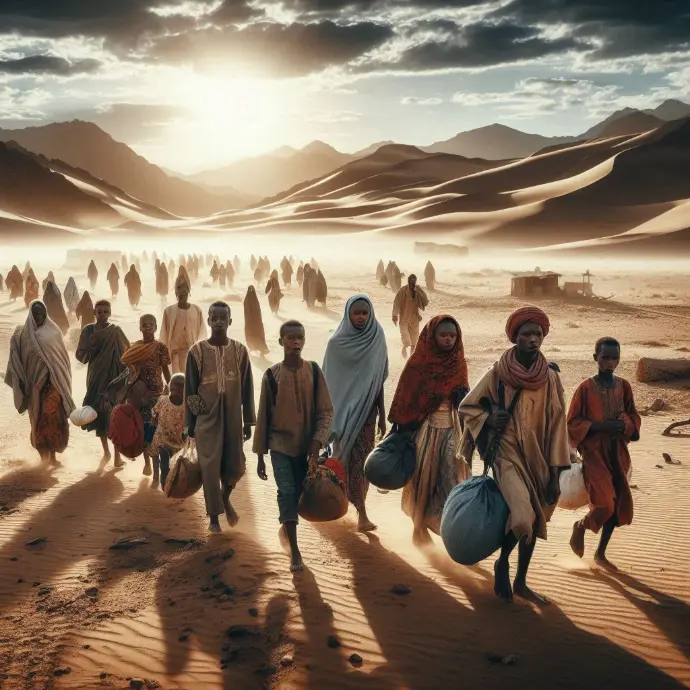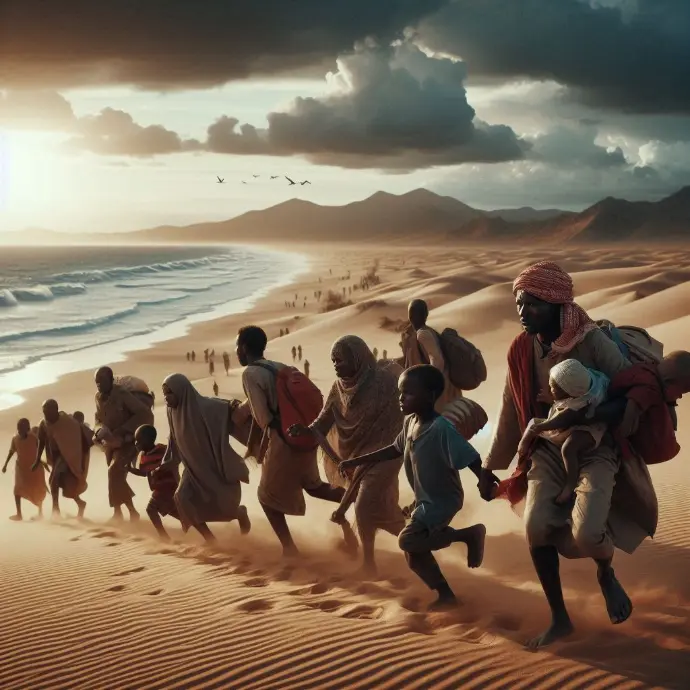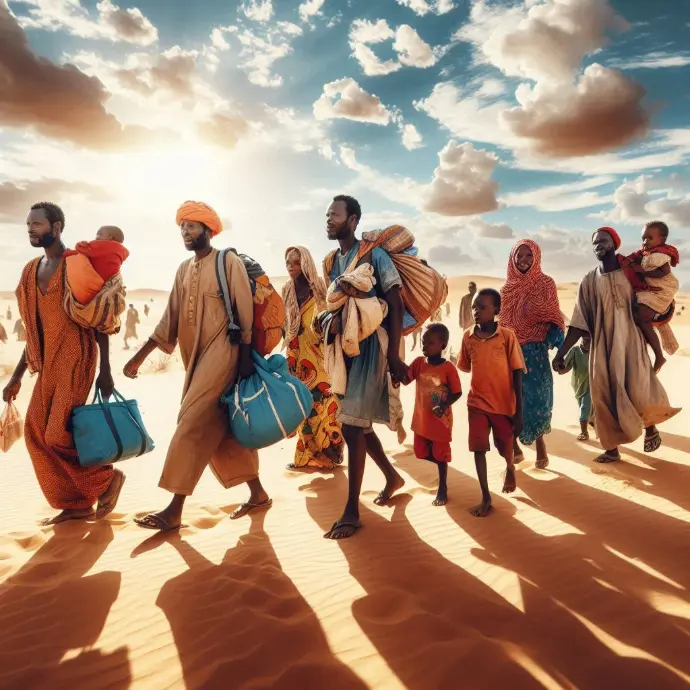
Crossing the Desert: Dangerous Routes and the Reality of African Refugees
Dive into the shocking reality of African refugees crossing dangerous routes in search of a safer future. Our feature article “Crossing the Desert: Dangerous Routes and the Reality of African Refugees” will give you an in-depth look at this global issue. Get ready for an informative journey that will challenge you to reflect and act. Go ahead and delve into a world of stories that need to be told!
Introduction
The African Refugee Crisis
Africa has faced an unprecedented refugee crisis, with millions of people displaced due to armed conflict, political persecution and widespread violence. The reality for African refugees is heartbreaking, with entire families fleeing their homes in search of safety and hope in an uncertain future.
Countries such as South Sudan, Somalia, the Democratic Republic of the Congo and Nigeria have witnessed a steady flow of refugees seeking asylum in neighbouring countries and beyond. This humanitarian crisis has put an overwhelming strain on available resources and led to extremely precarious living conditions for many African refugees.
The lack of long-term solutions has perpetuated the crisis, leaving millions trapped in an endless cycle of forced displacement and extreme vulnerability.

The routes used by African refugees to escape violence and persecution are notoriously dangerous, exposing the displaced to a range of deadly risks. The journey across the Sahara and the Mediterranean Sea, for example, has claimed countless lives and left many more in desperate situations.
Exposure to human traffickers, lack of food and water, harsh weather conditions and the possibility of being detained or illegally deported are just some of the difficulties faced by African refugees on these dangerous routes. Many also fall victim to exploitation, abuse and human trafficking on the way to safety.
The psychological impact of traversing these dangerous routes is also significant, leaving emotional scars on those who manage to reach their destination. The reality of African refugees is shaped by these traumatic experiences that leave a deep mark on their physical and mental well-being.
The current situation of African refugees remains precarious, with many facing a lack of access to basic services, including healthcare, adequate housing and education. Integration into host communities also presents challenges, as stigma and discrimination often make it difficult to pursue a dignified and sustainable life.
In addition, the COVID-19 pandemic has further exacerbated the vulnerability of African refugees, limiting their mobility and access to vital resources. Humanitarian organizations and governments face the difficult task of providing assistance in a global environment facing multiple simultaneous crises.
It is critical that urgent action be taken to address the reality of African refugees and ensure their long-term protection, safety and well-being. International collaboration and commitment to sustainable solutions are essential to address this ongoing humanitarian crisis.

Background to the crisis
The African refugee crisis is the result of a combination of factors that have led large numbers of people to flee their home countries in search of safety and a better life. The main causes of this displacement include armed conflict, political persecution, ethnic violence, extreme poverty and lack of economic opportunities. These factors have created an unstable and insecure environment for many people, forcing them to undertake dangerous journeys in search of refuge and protection in other countries.
The lack of security and the violation of human rights in many regions of Africa have contributed significantly to the increase in displacement. The absence of a strong legal framework for the protection of human rights, as well as corruption and political instability, have exacerbated the situation, driving thousands of people to leave their homes in search of safety and stability elsewhere.
Furthermore, climate change and its impacts on the availability of natural resources, such as water and arable land, have also played a role in increasing displacement, as entire communities have been forced to leave their homes due to the scarcity of basic resources for their subsistence.
According to the United Nations High Commissioner for Refugees (UNHCR), Africa is estimated to be home to more than 6.3 million refugees and 14.5 million internally displaced people. These figures reflect the magnitude of the humanitarian crisis facing the continent, with millions of people having to leave their homes in search of safety and protection.
In addition, it is estimated that around 1.8 million African refugees are in refugee camps in precarious conditions, with limited access to basic services such as health care, education and food. This situation highlights the urgent need for coordinated action at national and international levels to address the humanitarian needs of refugees and ensure their protection and well-being.
It is important to note that these figures only represent part of the reality, as many displaced people are not officially registered and face situations of extreme vulnerability without receiving the necessary assistance.
Escape routes used by African refugees, which often involve journeys across the desert and the sea, are fraught with significant dangers and challenges. The lack of safe and legal options to seek protection has led many refugees to resort to clandestine routes and to rely on human traffickers, exposing them to situations of extreme vulnerability and risk.
The journey across the desert presents additional challenges, such as exposure to extreme weather conditions, food and water shortages, as well as the risk of falling victim to violence by armed groups and human traffickers. In addition, many African refugees are forced to undertake dangerous sea journeys in precarious boats, facing the risk of shipwrecks and drowning on the high seas.
The lack of safe and legal avenues to seek international protection exacerbates the situation, forcing refugees to resort to dangerous routes and exposing them to extreme risk situations throughout their journey in search of safety and protection.
The African refugee crisis and dangerous routes have a significant impact on the international community. The pressure on host countries to provide shelter and assistance to refugees can lead to political and economic tensions. In addition, the international community is challenged to find sustainable solutions to address this humanitarian crisis.
Transit and destination countries often face difficulties in managing the constant flow of refugees, which can lead to overcrowding in camps, resource shortages and tensions with local communities. At a global level, the African refugee crisis highlights the need for greater cooperation between countries to address the underlying causes of forced displacement and work together to provide long-term solutions.
Furthermore, the impact of the African refugee crisis on the international community extends to issues of security, human rights and development. The need to protect refugee rights, prevent human trafficking and address the causes of forced displacement requires a comprehensive and collaborative approach at a global level.
Reality of African refugees
Refugee experiences on their journey
African refugees face grueling and dangerous journeys in their search for safety and opportunity. Many of them are fleeing armed conflict, political persecution and serious human rights violations in their home countries. During their journey, they face harrowing conditions, including a lack of food, clean water and adequate shelter. In addition, the journey often involves crossing deserts, traversing seas in rickety boats and facing unscrupulous human traffickers.
The experience of African refugees on their journey is a story of courage, resilience and the fight for survival. Many of them are forced to leave their loved ones behind and face an uncertain journey in search of a safer future. The difficulties they face along the way highlight the urgent need to protect and guarantee the rights of refugees at all stages of their journey.

African refugees face a number of significant challenges and risks on dangerous routes to safety. Exposure to extreme weather conditions, lack of food and water, and the risk of falling victim to violence and exploitation are just some of the difficulties they face on their journey. In addition, the journey often involves crossing international borders illegally, which increases refugees’ vulnerability to detention and deportation.
The lack of effective protection along these dangerous routes exposes African refugees to a greater risk of abuses and violations of their human rights. The international community has a responsibility to urgently and effectively address these challenges, ensuring the safety and security of refugees during their journey and upon arrival at their destination.
Behind every African refugee crossing dangerous routes is a story of overcoming and resilience. Despite the challenges and dangers they face on their journey, many African refugees demonstrate remarkable strength and determination to reach safety. Their personal stories are moving testimonies of the struggle for survival, hope and resilience in the face of adversity.
These personal stories of overcoming and resilience are a powerful reminder of the strength of the human spirit and the ability to recover in the face of the most difficult circumstances. By sharing these stories, the importance of providing support and protection to African refugees is highlighted, recognizing their bravery and contribution to the diversity and richness of the communities they reach.

Analysis of dangerous routes
Main routes used by African refugees
African refugees face multiple challenges when trying to escape violence, persecution and extreme poverty. The routes used to reach places of safe refuge are often extremely dangerous, with the journey through the Sahara Desert and the crossing across the Mediterranean Sea being two of the most common routes.
The route through the Sahara Desert is known to be one of the deadliest, with extreme temperatures, food and water shortages, and the constant threat of criminal gangs and human traffickers. On the other hand, the journey across the Mediterranean Sea carries similar risks, with overcrowded boats and precarious sailing conditions often resulting in human tragedies.
In addition, there are other land and sea routes that African refugees can take, but all present significant dangers and immense challenges for those seeking a better life away from adversity in their home countries.
On the route through the Sahara Desert, African refugees face dehydration, heat exhaustion, exposure to violence from criminal gangs and exploitation by unscrupulous human traffickers. On the other hand, on the journey across the Mediterranean Sea, refugees risk shipwrecks due to overloaded boats and adverse weather conditions, resulting in a high fatality rate.
In addition, on all routes, African refugees are vulnerable to abuse, extortion and human trafficking, further exacerbating the dangers they face in their desperate search for safety and protection.
Restrictive migration policies and the lack of legal and safe avenues to seek refuge have a devastating impact on the security of African refugees. The criminalization of migration, indiscriminate raids and detentions, as well as forced deportations, force refugees to resort to dangerous routes and rely on human traffickers to achieve their goal of finding a safe place to rebuild their lives.
The lack of humane and compassionate migration policies not only endangers the lives of refugees, but also perpetuates a cycle of vulnerability and despair, contributing to a growing humanitarian crisis.
Human smuggling and trafficking on the routes used by African refugees is an alarming reality. Traffickers often take advantage of the vulnerability of refugees, offering them supposed opportunities to reach safe places in exchange for exorbitant sums of money. This inhumane practice exposes refugees to extremely dangerous situations, with risks of abuse, exploitation and even death.
Furthermore, people smuggling on these routes fuels an illegal market that profits from the suffering of those seeking to escape violence and persecution. The lack of effective regulations and the presence of criminal groups that control these activities make African refugees easy prey for these smuggling and trafficking networks.
It is essential that global measures be taken to combat people smuggling and trafficking on the routes used by African refugees. This involves cooperation between countries, strengthening border security and establishing mechanisms that protect refugees and dismantle human trafficking networks.
International response and human rights
The role of governments and international organizations is critical in protecting and assisting African refugees who traverse dangerous routes in search of safety and better living conditions. Governments have a responsibility to ensure that the human rights of refugees are respected, in accordance with international humanitarian law and refugee conventions.
It is critical that governments and international organizations work together to address the challenges faced by African refugees, providing protection, assistance and sustainable solutions for this vulnerable population.

Addressing the African refugee crisis and dangerous routes from a human rights perspective involves adopting strategies that respect, protect and fulfil the fundamental rights of these vulnerable people. One of the key strategies is to ensure access to a fair and efficient asylum application process. This involves providing African refugees with the opportunity to seek international protection and demonstrate the need for refuge without being subjected to discrimination or inhumane treatment.
Another important strategy is to ensure that African refugees have access to basic services such as health care, shelter, food and education. These services are fundamental to guaranteeing their dignity and well-being, and must be provided without discrimination. In addition, it is crucial to implement integration programmes that facilitate the inclusion of African refugees in host communities, promoting solidarity and peaceful coexistence.
Furthermore, it is essential to address the underlying causes of forced migration and displacement, which requires a focus on preventing conflict, promoting sustainable development and protecting human rights in countries of origin. This involves working in collaboration with governments, international organisations and civil society to address the conditions that force Africans to flee their homes in search of safety and opportunity.

Conclusions
Long-term impact on the lives of African refugees
The reality of African refugees traversing dangerous routes has a significant impact on their lives in the long term. Many of them experience emotional trauma due to the difficult conditions in which they are forced to live. In addition, uncertainty about their future and lack of access to basic resources such as education and adequate health care contribute to a deterioration in their quality of life.
Forced displacement can also have long-lasting effects on the mental and emotional health of African refugees. Exposure to situations of violence, loss of loved ones and feelings of insecurity can lead to psychological disorders that require specialized care. This long-term impact highlights the importance of implementing support and rehabilitation programs for African refugees who have traversed dangerous routes in search of safety and protection.
Integration into new environments and overcoming traumatic experiences also represent significant challenges for African refugees, underlining the need to put in place ongoing support measures in order to ensure their long-term well-being.
Given the reality of African refugees facing dangerous routes, it is crucial to implement concrete actions to ensure their safety and protection. First, it is essential to strengthen international cooperation to address the underlying causes of displacement and work on preventing conflicts and humanitarian crises in Africa.
Furthermore, greater investment is required in creating safe and legal pathways for African refugees to seek protection in other countries, thus avoiding exposure to dangerous routes and people smuggling networks. It is also necessary to improve the capacity of host countries to offer reception and protection to refugees, ensuring access to basic services and integration opportunities.
Another crucial aspect is the protection of the human rights of African refugees, including measures to prevent discrimination and xenophobia. This requires a comprehensive approach ranging from protection in countries of origin to integration in host countries, ensuring respect for the dignity and fundamental rights of these vulnerable people.
Given the complex reality of African refugees facing dangerous routes, the global community plays a critical role in resolving this humanitarian crisis. It is necessary to foster solidarity and cooperation among countries to comprehensively address the challenges associated with the forced displacement of Africans.
The global community must commit to providing financial and technical support to countries affected by the flow of refugees, as well as to humanitarian organizations working to protect and assist these vulnerable populations. Furthermore, it is crucial to promote a human rights-based approach in all initiatives related to the management of the African refugee crisis, ensuring that their fundamental rights are respected and protected at all times.
Raising public awareness and mobilizing resources are equally important to address the reality of African refugees traversing dangerous routes. Disseminating accurate information and fostering empathy towards African refugees are fundamental steps to raise awareness of this crisis and promote concrete actions at the global level.

 IHRO NEWS
IHRO NEWS